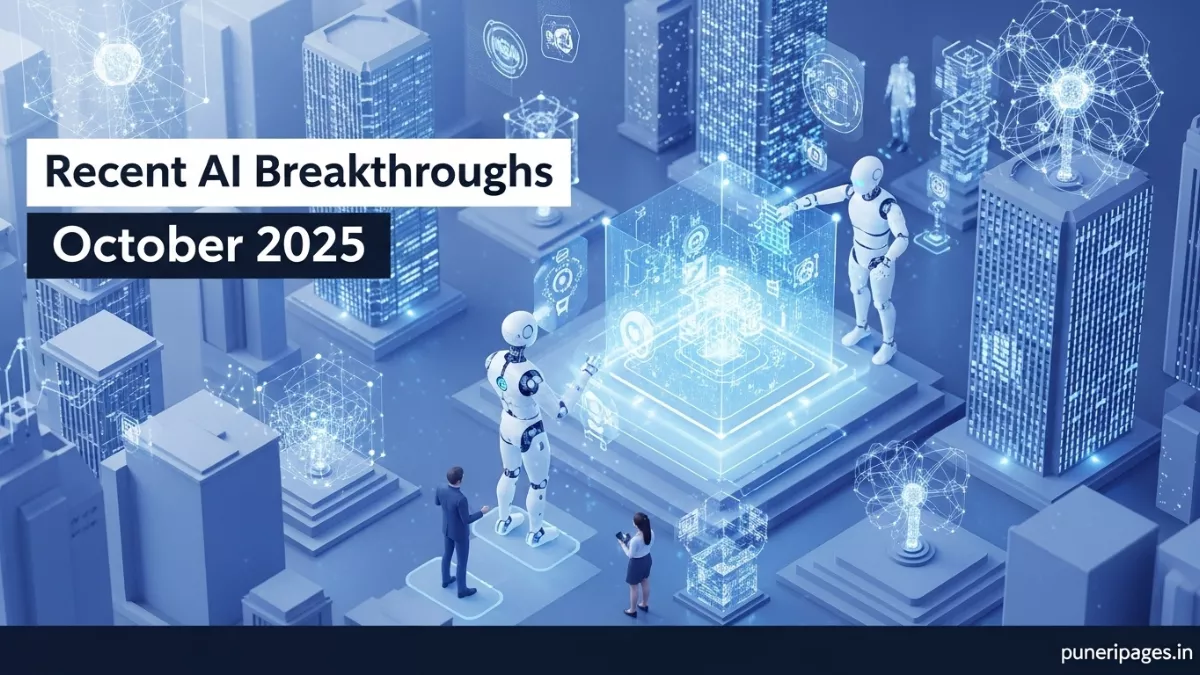
Recent AI Breakthroughs October 2025 are transforming automation, innovation, and global industries.
By Prashant for PuneriPages.in
Artificial Intelligence continues its rapid evolution and within October 2025, multiple significant breakthroughs have been announced by leading research institutes and corporations. We highlight the most transformative advancements — from generative models and machine-learning optimizations to robotics integration and sustainable AI systems. These innovations are reshaping industries and redefining the boundaries of what’s possible in AI.
Table of Contents
Generative Models Reach New Scale and Efficiency
In October 2025, several teams unveiled next-generation generative AI models that surpass previous performance benchmarks while reducing compute requirements. One model introduced by a major cloud provider achieves 60 billion parameter scale yet runs inference in under 100 milliseconds per query. The implications for real-time content creation, interactive virtual assistants, and personalised media generation are profound.
Key features include:
- Multi-modal generation: images, text, code and 3D assets from a single prompt
- Fine-tuned domain-specific versions requiring only a few hundred examples
- Energy-efficient architectures that cut power consumption by 40% compared to 2024 models
These advancements enable smaller organisations and edge devices to leverage generative AI previously reserved for major cloud super-clusters.
Robotics and Autonomous Agents Get Adaptive Learning Systems
Another cornerstone announcement in October saw an AI robotics company release the first general-purpose adaptive robotic agent that learns new tasks within hours of deployment. The system uses reinforcement-learning, transfer-learning and self-supervised vision to:
- Locate and manipulate previously unseen objects
- Navigate dynamic environments without pre-training
- Collaboratively work with humans in shared spaces
Such a robotic agent marks a shift from fixed-program automation to adaptive, intelligence-driven robotics. Industries such as logistics, manufacturing, and service-deployment stand to gain immediate productivity lift.
AI for Sustainability: Climate Models and Resource Management
October’s breakthroughs also extended into sustainable AI. A leading climate research institute announced an AI-driven predictive model that uses satellite imagery and real-time sensor data to forecast wildfire spread, flood risks and crop yield changes. The model uses Graph Neural Networks to represent environmental factors and informs resource allocation for emergency response.
Highlights:
- 95 % accuracy in 72-hour wildfire spread forecasts across six continents
- Real-time integration with drone fleets for targeted suppression
- Predictive crop-yield modelling for small farmers, reducing post-harvest losses by an estimated 15 %
These developments show how AI is not just about profit, but about planetary resilience and social good.
Quantum-AI Hybrid Models Move from Theory into Practice
One of the most striking announcements came from a quantum computing laboratory: a working quantum-enhanced machine learning system that accelerates specific optimization tasks by an order of magnitude. Although still early-stage, this hybrid system:
- Combines classical neural networks with quantum annealing sub-modules
- Demonstrates speed-ups in logistics optimization, drug discovery and portfolio management
- Opens the door to commercially viable quantum-AI services within two years
October’s milestone is a major step from academic speculation into real-world application.
Ethical and Regulatory AI Advances: Explainability Gets Real
Recognising the need for trustworthy AI, October also brought breakthroughs in explainable and auditable AI systems. A consortium of governments and tech companies launched an open-source framework that:
- Visualises decision-paths in deep-learning models
- Enables “what-if” inspection of model behaviour under data shifts
- Certifies models as “compliance-ready” for sectors like healthcare, finance and insurance
This means enterprises can now deploy powerful AI systems while maintaining accountability and regulatory traceability.
Enterprise AI Platforms Integrate “Copilot-Ecosystems”
Major cloud vendors unveiled enterprise platforms that embed AI copilots across business operations. Features include:
- Auto-generation of internal reports, board-level summaries and compliance documents
- Real-time correction of faulty data entry using contextual AI
- Seamless integration with existing ERP, CRM and supply-chain systems
Businesses adopting these platforms are reporting productivity gains of up to 30 % within the first quarter.
Impacts on Industries: What these Breakthroughs Mean Now
Media & Entertainment
Generative models produce high-quality video, animation and interactive gaming assets at a fraction of current cost and time. Creative studios are integrating AI streams directly into production pipelines.
Manufacturing & Logistics
Adaptive robotic agents are deployed in warehouses, factories and for last-mile delivery. Quantum-AI hybrids optimise routing, scheduling and equipment utilisation with unprecedented speed.
Climate & Agriculture
Sustainable AI frameworks provide actionable insights for disaster response, crop management and natural resource allocation — strengthening resilience in vulnerable communities.
Financial Services
Hybrid quantum-AI systems and explainability frameworks allow firms to model risk, optimise portfolios and comply with regulatory demands — opening new competitive frontiers.
Challenges and Risks Still Ahead
Despite the progress, we must note critical challenges:
- Data privacy and misuse remain concerns as generative models become more accessible.
- Energy consumption of large models, though improving, still presents a sustainability question.
- Bias and fairness in AI decision systems require robust oversight and auditing.
- Workforce disruption is inevitable as adaptive robots and AI-copilots remove manual tasks — reskilling is urgent.
Looking Ahead: What Comes Post-October 2025
We anticipate the following trends based on October’s announcements:
- Wider edge-AI deployment, bringing generative models to smartphones and IoT devices.
- Commercial rollout of quantum-AI services for enterprise optimization.
- Scaling of adaptive robotics across new sectors such as eldercare and hospitality.
- Stronger regulatory frameworks forcing explainability as default in AI systems.
- Continued growth of AI for good, focusing on climate resilience and equitable access.
Conclusion
The recent AI breakthroughs announced within month of October 2025 mark a turning point — blending generative creativity, adaptive automation, climate intelligence, quantum-hybrid optimisation and accountable AI. Together, they form a potent synergy capable of redefining multiple industry landscapes.
We are now entering a phase where AI is not just a tool — it partners in innovation, sustainability and human advancement. For businesses, researchers and policy makers alike, October 2025 will likely be remembered as a watershed month in the journey of artificial intelligence.